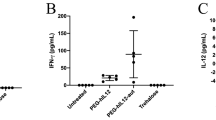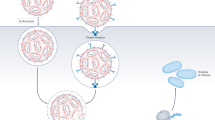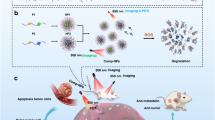Abstract
Gene therapy provides a promising approach for cancer treatment. Earlier studies suggested that poly-L-lysine-modified iron oxide nanoparticles (IONP-PLL) might be a promising gene delivery system that can transfect DNA efficiently in vitro and in vivo. In this study we used IONP-PLL as gene carriers to deliver the NM23-H1 gene, the first suppressor gene of cancer metastasis, to tumor cells in vivo. The intravenous injection of IONP-PLL carrying NM23-H1-GFP plasmid DNA significantly extended the survival time of an experimental pulmonary metastasis mouse model. In the IONP-PLL/NM23-H1-GFP-treated group, metastasis was clearly suppressed compared with the group treated with free NM23-H1-GFP plasmid. Furthermore, this gene therapy combined with cyclophosphamide treatment resulted in longer survival times and greater suppression of metastasis growth. In conclusion, treatment with IONP-PLL nanoparticles incorporating the NM23-H1gene is an efficient gene therapy method, and it is even more effective in combination with chemotherapy. This approach appears to be a promising strategy for treatment of metastatic tumors.
This is a preview of subscription content, access via your institution
Access options
Subscribe to this journal
Receive 12 print issues and online access
$259.00 per year
only $21.58 per issue
Buy this article
- Purchase on Springer Link
- Instant access to full article PDF
Prices may be subject to local taxes which are calculated during checkout





Similar content being viewed by others
References
Gardlík R, Pálffy R, Hodosy J, Lukács J, Turna J, Celec P . Vectors and delivery systems in gene therapy. Med Sci Monit 2005; 11: 110–121.
Wu Q, Moyana T, Xiang J . Cancer gene therapy by adenovirus-mediated gene transfer. Curr Gene Ther 2001; 1: 101–122.
Lundstrom K . Latest development in viral vectors for gene therapy. Trends Biotechnol 2003; 21: 117–122.
Lundstrom K, Boulikas T . Viral and non-viral vectors in gene therapy: technology development and clinical trials. Technol Cancer Res Treat 2003; 2: 471–486.
Merdan T, Kopecek J, Kissel T . Prospects for cationic polymers in gene and oligonucleotide therapy against cancer. Adv Drug Deliv Rev 2002; 54: 715–758.
Matsuura M, Yamazaki Y, Suqiyama M, Kondo M, Ori H, Nango M et al. Polycation liposome-mediated gene transfer in vivo. Biochim Biophys Acta 2003; 1612: 136–143.
Kushibikil T, Matsumoto K, Nakamura T, Tabata Y . Suppression of tumor metastasis by NK4 plasmid DNA released from cationized gelatin. Gene Therapy 2004; 11: 1205–1214.
Ogris M . Non-viral cancer gene therapy—what is best? Drug Discovery Today 2003; 8: 63.
Gasco MR, Gasco P . Nanovector. Nanomedicine 2007; 2: 955–960.
Ferrari M . Nanovector therapeutics. Curr Opin Chem Biol 2005; 9: 343–346.
Li Z, Zhu SG, Gan K, Zhang Q, Zeng Z, Zhou Y et al. Poly-L-lysine-modified silica nanoparticles: a potential oral gene delivery system. J Nanoscience and Nanotechnology 2005; 5: 1199–1203.
Ferrari M . Cancer nanotechnology: opportunities and challenges. Nat rev Cancer 2005; 5: 161–171.
Duncan R . The dawning era of polymer therapeutics. Nat Rev Drug Discov 2003; 2: 347–360.
Santhakumaran LM, Thomas T, Thomas TJ . Enhanced cellular uptake of triplex-forming oligonucleotide by nanoparticle formation in the presence of polypropylenimine dendrimers. Nucleic Acids Res 2004; 32: 2102–2112.
Zhu SG, Lu HB, Xiang JJ, Tang K, Zhang BC, Zhou M, et al. A novel nonviral nanoparticle gene vector: poly-L-lysine silica nanoparticles. Chin Sci Bull 2002; 47: 654–657.
Zhu SG, Xiang JJ, Li XL, Shen SR, Lu HB, Zhou J et al. Poly(L-lysine)-modified silica nanoparticles for delivery of antisence oligonucleotides. Biotechnol Appl Biochem 2004; 39: 179–187.
Xiang JJ, Zhu SG, Lu HB, Ruan JM, Zhang BC, Li J et al. Use of Magnetic iron oxide nanoparticles as gene carrier. Chinese Journal of cancer 2001; 10: 1009–1014.
Xiang JJ, Tang JQ, Zhu SG, Nie XM, Lu HB, Shen SR et al. IONP-PLL: a novel non-viral vector for efficient gene delivery. J Gene Medicine 2003; 5: 803–817.
Steeg PS, Bevilacqua G, Kopper L, Thorgeirsson UP, Talmadge JE, Liotta LA et al. Evidence for a novel gene associated with low tumor metastatic potential. J Natl Cancer Inst 1988; 80: 200–204.
Sgouros J, Galani E, Gonos E, Moutsatsou P, Belechri M, Skarlos D et al. Correlation of NM23-H1 gene expression with clinical outcome in patients with advanced breast cancer. In Vivo 2007; 21: 519–522.
Horak CE, Mendoza A, Vega-Valle E, Albaugh M, Graff-Cherry C, McDermott WG et al. NM23-H1 suppresses metastasis by inhibiting expression of the lysophosphatidic acid receptor EDG2. Cancer Res 2007; 67: 11751–11759.
Boissan M, Wendum D, Arnaud-Dabernat S, Munier A, Debray M, Lascu I et al. Increased lung metastasis in transgenic NM23-Null/SV40 mice with hepatocellular carcinoma. J Natl Cancer Inst 2005; 97: 836–845.
Che G, Chen J, Liu L, Wang Y, Li L, Qin Y et al. Transfection of NM23-H1 increased expression of beta-Catenin, E-Cadherin and TIMP-1 and decreased the expression of MMP-2, CD44v6 and VEGF and inhibited the metastatic potential of human non-small cell lung cancer cell line L9981. Neoplasma 2006; 53: 530–537.
Prowatke I, Devens F, Benner A, Gröne EF, Mertens D, Gröne HJ et al. Expression analysis of imbalanced genes in prostate carcinoma using tissue microarrays. Br J Cancer 2007; 96: 82–88.
Ferenc T, Lewinski A, Lange D, Niewiadomska H, Sygut J, Sporny S et al. Analysis of NM23-H1 protein immunoreactivity in follicular thyroid tumors. Pol J Pathol 2004; 55: 149–153.
Leone A, Seeger RC, Hong CM, Hu YY, Arboleda MJ, Brodeur GM et al. Evidence for Nm23 RNA overexpression, DNA amplification and mutation in aggressive childhood neuroblastomas. Oncogene 1993; 8: 855–865.
Pavelic K, Kapitanovic S, Radosevic S, Bura M, Seiwerth S, Paveliæ LJ et al. Increased activity of NM23-H1 gene in squamous cell carcinoma of the head and neck is associated with advanced disease and poor prognosis. Mol Med 2000; 78: 111–118.
Fishbach M, Settleman J . Specific biochemical inactivation of oncogenic ras proteins by nucleoside diphosphate kinase. Cancer Res 2003; 63: 4089–4094.
Engel M, Veron M, Theisinger B, Lacombe ML, Seib T, Dooley S et al. A novel serine/threonine-specific protein phosphotransferase activity of Nm23/nucleoside-diphosphate kinase. Eur J Biochem 1995; 234: 200–207.
Lombardi D, Mileo AM . Protein interactions provide new insight into Nm23/nucleoside diphosphate kinase functions. J Bioenerg Biomembr 2003; 5: 67–71.
Giehl K . Oncogenic Ras in tumour progression and metastasis. Biol Chem 2005; 386: 193–205.
Salerno M, Palmieri D, Bouadis A, Halverson D, Steeg PS . NM23-H1 metastasis suppressor expression level influences the binding properties, stability, and function of the kinase suppressor of Ras1 (KSR1) Erk scaffold in breast carcinoma cells. Mol Cell Biol 2005; 25: 1379–1388.
Hartsough MT, Morrison DK, Salerno M, Palmieri D, Quatas T, Mair M et al. NM23-H1 metastasis suppressor phosphorylation of kinase suppressor of Ras via a histidine protein kinase pathway. J Biol Chem 2002; 277: 32389–32399.
Jung HY, Seong HA, Ha HJ . NM23-H1 tumor suppressor and its interacting partner STRAP activate p53 function. J Biol Cem 2007; 282: 35293–35307.
Xiang JJ, Nie XM, Tang JQ, Wang YJ, Li Z, Gan K et al. In vitro gene transfection by magnetic iron oxide nanoparticles and the effect of magnetic field on the efficiency of transfection. Zhonghua Zhong Liu Za Zhi 2004; 26: 71–74.
Lee H, Lee E, Kim do K, Jang NK, Jeong YY, Jon S . Antibiofouling polymer-coated superparamagnetic iron oxide nanoparticles as potential magnetic resonance contrast agents for in vivo cancer imaging. J Am Chem Soc 2006; 128: 7383–7389.
Hanessian S, Grzyb JA, Cengelli F, Juillerat-Jeanneret L . Synthesis of chemically functionalized superparamagnetic nanoparticles as delivery vectors for chemotherapeutic drugs. Bioorg Med Chem 2008; 16: 2921–2931.
Pan BF, Cui DX, Sheng Y, Ozkan C, Gao F, He R et al. Dendrimer-modified magnetic nanoparticles enhance efficiency of gene delivery system. Cancer Res 2007; 67: 8156–8163.
Safarik I, Safarikova M . Magnetic techniques for the isolation and purification of proteins and peptides. Biomagn Res Technol 2004; 2: 7.
Chemla YR, Grossman HL, Poon Y, McDermott R, Stevens R, Alper MD et al. Ultrasensitive magnetic biosensor for homogeneous immunoassay. Proc Natl Acad Sci USA 2000; 97: 14268–14272.
Kim DH, Lee SH, Kim KN, Kim KM, Chim IB, Lee YK . Cytotoxicity of ferrite particles by MTT and agar diffusion methods for hyperthermic application. J Magn Magn Mater 2005; 293: 287–292.
Hirsch LR, Stafford RJ, Bankson JA, Sershen SR, Rivera B, Price RE et al. Nanoshell-mediated near-infrared thermal therapy of tumors under magnetic resonance guidance. Proc Natl Acad Sci USA 2003; 100: 13549–13554.
Gao L, Zhuang J, Nie L, Zhang J, Zhang Y, Gu N et al. Intrinsic peroxidase-like activity of ferromagnetic nanoparticles. Nat Nanotechnol 2007; 2: 577–583.
Morishita N, Nakagami H, Morishita R, Takeda S, Mishima F, Terazono B et al. Magnetic nanoparticles with surface modification enhanced gene delivery of HVJ-E vector. Biochem Biophys Res Commun 2005; 334: 1121–1126.
Gupta AK, Naregalkar RR, Vaidya VD, Gupta M . Recent advances on surface engineering of magnetic iron oxide nanoparticles and their biomedical applications. Nanomedicine 2007; 2: 23–39.
Sonabend AM, Velicu S, Ulasov IV, Han Y, Tyler B, Brem H et al. A safety and efficacy study of local delivery of interleukin-12 transgene by PPC polymer in a model of experimental glioma. Anticancer Drugs 2008; 19: 133–142.
He C, He P, Zhu YS . Expression of NM23-H1-GFP fusion protein in human lung cancer cells and its effect on in vitro invasive potential of tumor cells. Chin J Biochem Mol Biol 2000; 16: 51–56.
Acknowledgements
This study was supported by the State Key Science Research Program of China (2006CB910502, 2006CB910504), The 111 project (111-2-12), The National ‘863’ High Technology Program of China (2007AA02Z170).
Author information
Authors and Affiliations
Corresponding author
Rights and permissions
About this article
Cite this article
Li, Z., Xiang, J., Zhang, W. et al. Nanoparticle delivery of anti-metastatic NM23-H1 gene improves chemotherapy in a mouse tumor model. Cancer Gene Ther 16, 423–429 (2009). https://doi.org/10.1038/cgt.2008.97
Received:
Revised:
Accepted:
Published:
Issue Date:
DOI: https://doi.org/10.1038/cgt.2008.97
Keywords
This article is cited by
-
Nm23-H1 induces apoptosis in primary effusion lymphoma cells via inhibition of NF-κB signaling through interaction with oncogenic latent protein vFLIP K13 of Kaposi’s sarcoma-associated herpes virus
Cellular Oncology (2022)
-
Magnetic Nanostructures for Cancer Theranostic Applications
Current Pathobiology Reports (2021)
-
Foot-and-mouth disease virus induces lysosomal degradation of NME1 to impair p53-regulated interferon-inducible antiviral genes expression
Cell Death & Disease (2018)
-
Progress on Nme (NDP kinase/Nm23/Awd) gene family-related functions derived from animal model systems: studies on development, cardiovascular disease, and cancer metastasis exemplified
Naunyn-Schmiedeberg's Archives of Pharmacology (2015)
-
Treating metastatic cancer with nanotechnology
Nature Reviews Cancer (2012)



